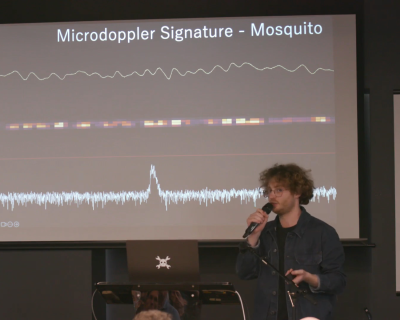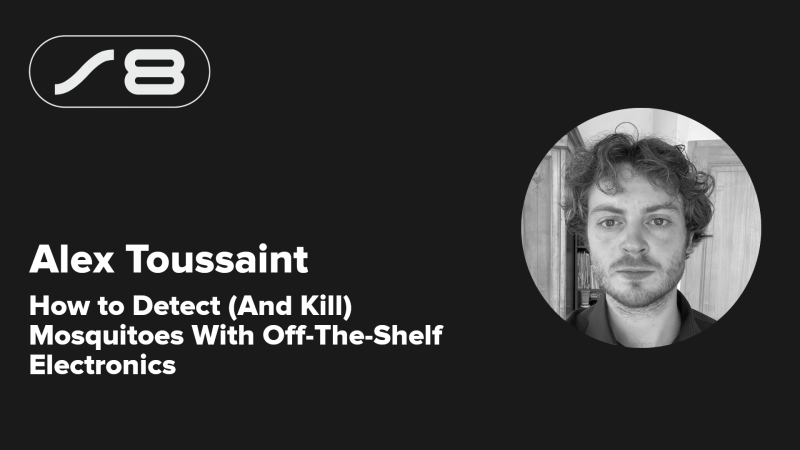Suppose that you want to get rid of a whole lot of mosquitoes with a quadcopter drone by chopping them up in the rotor blades. If you had really good eyesight and pretty amazing piloting skills, you could maybe fly the drone yourself, but honestly this looks like it should be automated. [Alex Toussaint] took us on a tour of how far he has gotten toward that goal in his amazingly broad-ranging 2024 Superconference talk. (Embedded below.)
The end result is an amazing 380-element phased sonar array that allows him to detect the location of mosquitoes in mid-air, identifying them by their particular micro-doppler return signature. It’s an amazing gadget called LeSonar2, that he has open-sourced, and that doubtless has many other applications at the tweak of an algorithm.
Rolling back in time a little bit, the talk starts off with [Alex]’s thoughts about self-guiding drones in general. For obstacle avoidance, you might think of using a camera, but they can be heavy and require a lot of expensive computation. [Alex] favored ultrasonic range finding. But then an array of ultrasonic range finders could locate smaller objects and more precisely than the single ranger that you probably have in mind. This got [Alex] into beamforming and he built an early prototype, which we’ve actually covered in the past. If you’re into this sort of thing, the talk contains a very nice description of the necessary DSP.
 [Alex]’s big breakthrough, though, came with shrinking down the ultrasonic receivers. The angular resolution that you can resolve with a beam-forming array is limited by the distance between the microphone elements, and traditional ultrasonic devices like we use in cars are kinda bulky. So here comes a hack: the TDK T3902 MEMS microphones work just fine up into the ultrasound range, even though they’re designed for human hearing. Combining 380 of these in a very tightly packed array, and pushing all of their parallel data into an FPGA for computation, lead to the LeSonar2. Bigger transducers put out ultrasound pulses, the FPGA does some very intense filtering and combining of the output of each microphone, and the resulting 3D range data is sent out over USB.
[Alex]’s big breakthrough, though, came with shrinking down the ultrasonic receivers. The angular resolution that you can resolve with a beam-forming array is limited by the distance between the microphone elements, and traditional ultrasonic devices like we use in cars are kinda bulky. So here comes a hack: the TDK T3902 MEMS microphones work just fine up into the ultrasound range, even though they’re designed for human hearing. Combining 380 of these in a very tightly packed array, and pushing all of their parallel data into an FPGA for computation, lead to the LeSonar2. Bigger transducers put out ultrasound pulses, the FPGA does some very intense filtering and combining of the output of each microphone, and the resulting 3D range data is sent out over USB.
 After a marvelous demo of the device, we get to the end-game application: finding and identifying mosquitoes in mid-air. If you don’t want to kill flies, wasps, bees, or other useful pollinators while eradicating the tiny little bloodsuckers that are the drone’s target, you need to be able to not only locate bugs, but discriminate mosquitoes from the others.
After a marvelous demo of the device, we get to the end-game application: finding and identifying mosquitoes in mid-air. If you don’t want to kill flies, wasps, bees, or other useful pollinators while eradicating the tiny little bloodsuckers that are the drone’s target, you need to be able to not only locate bugs, but discriminate mosquitoes from the others.
For this, he uses the micro-doppler signatures that the different wing beats of the various insects put out. Wasps have a very wide-band doppler echo – their relatively long and thin wings are moving slower at the roots than at the tips. Flies, on the other hand, have stubbier wings, and emit a tighter echo signal. The mosquito signal is even tighter.
If you told us that you could use sonar to detect mosquitoes at a distance of a few meters, much less locate them and differentiate them from their other insect brethren, we would have thought that it was impossible. But [Alex] and his team are building these devices, and you can even build one yourself if you want. So watch the talk, learn about phased arrays, and start daydreaming about what you would use something like this for.
















“we would have thought that it was impossible” – it WAS, until now
So I guess we decided not to call mosquitoes living/breathing/feeling beings to start mass murdering them.
Apparantly, you don’t live in Florida.
Well, to be fair, this is really more a matter of self-defense than murder.
As the developer noted (if you’d watched the video), mosquitos kill more than 1 million people each year.
I’m pretty sure they started it too and I think this has been going on for a while … about time someone started fighting back …
But, but, but: Mosquitos don’t kill people, smaller life forms hitching rides in mosquitos kill people!
I guess you have not had family members who have suffered from or died of malaria.
“I guess you have not had family members who have suffered or died at the hands of [ethnic group]”
See how that works? Compassion hostage-taking isn’t smart or moral, it’s despicable actually
And this might seem hyperbolic, i know, but keep in mind this subject is about deleting at least two species from existence. In reality it would absolutely be more.
I think it deserves more thought than “what if this disease didn’t exist.” Did the mosquitos choose to spread the disease? Did the other animals that eat them choose to eat such a heinous criminal? They matter.
I wonder if the system could be modified to detect trolls and chop up their keyboard cables 🤔
I wish!
As someone who apparently possesses multiple qualities that make me extremely appealing to mosquitos:
Kill. Them. All.
Absolutely no remorse. Kill them dead. Dead dead. All of them.
Yes! Absolutely! As a microbiologist I am tempted to reclassify them as just disease vectors.
Interesting, life imitates art, Harry Harrison and Marvin Minsky wrote a book where the world’s first actual AI was stolen and butchered to run a robot which killed pests on crops.
Imagine thinking that there are zero knock-on effects for eradicating such a huge biomass from an area’s food chain in so many parts of the world. I know people say that you could safely eradicate mosquitos, and that there are “studies” (done by idiots) saying so, but it isn’t true. It OBVIOUSLY isn’t true. Even the stated purpose of eliminating the mosquitoes (eliminating malaria, saving millions of lives) proves that it isn’t true. Those lives are also part of the environment, and eliminating all selective pressure on a population because you feel sorry for it isn’t actually a compassionate thing to do.
I swear, people want to eradicate EVERY downward population force on the third world so they become packed to the gills with billions and starve even more. And then they want to set up funnels to pack up these people like sardines and ship them into every other country by the tens of millions per year. And they call that being moral, being compassionate. We basically need to treat the advocates of these sorts of policies as enemy combatants for the next five decades until we’ve entirely eradicated them, just like the mosquitoes.
Temptations towards massive global social and environmental engineering should be treated as taboo as pedophilia.
Disregarding most of the self-righteous, anti-human drivel in your comment…
You obviously don’t realize that, if the “food chain” was taking care of the “biomass” in question, there wouldn’t be enough of them to warrant a tool to reduce their population! There is obviously no existing predator that can handle the load, thus, humans step in and take care of the problem. And in an ingenious way, IMO.
And that is beside the fact that simply killing the disease-carrying filth in NO WAY removes the biomass from the environment. It simply makes it available to soil microbes in a more efficient and direct manner.
Disregarding your banal slave morality…
You obviously haven’t thought this through. Is plankton a massive biomass? Does that imply it’s not being utilized? Is it important to the local and global biome?
If we simply killed the plankton with massive swarms of automated gizmos and it all sank to the sea bottom, would that not harm the environment because technically the energy went somewhere?
All of that would be considered insane on its face, and the only reason you don’t think the mosquito example is the same is because you are being emotionally held hostage by malaria suffering.
Allow me to code-switch to language that some people here might better understand: all of this is simply colonial management with much-updated public relations.
What i mean is that it is not kind to people to meddle with the ecosystem in which hundreds of ethnicities have adapted for dozens of millennia, all with the arrogance of an engineer who is assured that he knows best because he can program a robot… It’s not nice to balloon their populations and then make them wholly dependent on food and fertilizer aid from your country. It’s not nice to then solve the ensuing problems by relocating them en masse away from their homeland and culture, to your own economic gain. It’s the same old story with a new ad campaign.
Would the moral calculus of all this change if the population of the world reached a trillion? No, that would simply be 990 billion more hostages for the cause. At some point difficult and honest assessments must be made to avert far worse tragedies. Subjecting one’s own ego to this reality check is part of real compassion.
“And then they want to set up funnels to pack up these people like sardines and ship them into every other country by the tens of millions per year.”
“It’s not nice to then solve the ensuing problems by relocating them en masse away from their homeland and culture, to your own economic gain.”
I don’t know if you got the message, but slavery has been abolished for some time.
Ships relocating people for economic gain had sails. They too have mostly gone.
And even the transatlantic slave trade never amounted to tens of millions per year.
So tell me, who exactly ships tens of millions of people per year against their will and from where to where?
Aren’t you engaging in a “little” hyperbole?
Slavery may have been abolished, but it’s still alive and well in many parts of the world. But yes, I think some hyperbole might have crept in.
Why is it OBVIOUSLY not true? We eliminated the Dodo with no ill effects. Currently we are losing approximately three species worldwide per hour (depending on which report you read). Why couldn’t one of them be the mosquito?
The Dodo was never a significantly large biomass and was always relegated to an isolated micro-biome. Not a good-faith parallel and you know it. Insect populations are already collapsing, and of course this thing is going to scoop up many other species besides mosquito if it is automated at mass-scale. Don’t try and tell me it won’t.
But yes, the mosquito alone is going to cause huge problems if you eradicate it. NOT LIKE THE FRIGGIN DODOBIRD or a bunch of other fringe species which were basically on death’s door anyway. Some species require massive interventions to prevent from going extinct; this one would require unheard of interventions to even make it endangered. And that correlates directly with its importance to the food chain.
You should probably wipe the flecks of spittle off your screen now.
Nothing to say, so you resort to ridiculing the other for his pathos. A trend that is thankfully losing a lot of popularity.
Replying to TG.
No, I was mocking you for your righteous indignation at plans to kill all mosquitos even though they are a disease vector. You then went on to compare this to killing all plankton, which nobody is suggesting, and would be stupid. In addition you suggested that some populations have “adapted” to living in a malaria-laced hellhole, so we shouldn’t try to reduce their suffering. To cap it all you claim that intervening to reduce the mosquito population to reduce the sickness and death it causes will lead to increased population which itself will cause more misery. So we should let them die?
Education is the solution. Unfortunately you probably missed out, but there is still time. Read a book or something.
I’m glad you always post under the same name, but your comments would always be so obviously dumb it wouldn’t matter. Catch you at the next Eugenics Conference!
@Andrew…
If you caught other comments under my initials only in this one thread, you’d understand it’s not eugenics but honesty in charity that matters. I’ve worked in Africa. I’ve faced malaria. I’ve seen its toll.
What I’m tired of is the easy-yet-dopamine-rewarding qualities of certain kinds of charity. The kinds that stroke one’s ego, yet you don’t see the results of it five, ten, eighty years hence. Very unluckily, we have centuries of this record in Africa.
The charity which matters is the one which is brave enough—to see the region as a whole continent of nature and peoples, one which has existed and flourished longer than any other, and does not need the young engineer-as-savior to redeem it, no matter how much it strokes the interior morals of “doing good” in a short-term first-world way.
Is the current weight of humanity destroying the world or not? It seems to depend on the subject. If it’s about ambiguous energy generation, sans borders, it’s a hard yes. If it’s about teeming peoples struggling thousands of miles away, the story changes. Be consistent.
Ninety Nine percent of all species that ever lived are extinct.
And yet, here we are. Life… always finds a way.
“would require unheard of interventions to even make it endangered.”
It would require a gene drive, a simple and mature technology that has already been deployed at scale (to eliminate species that threaten commercially valuable livestock).
The prospect of using it to extinguish disease-carrying mosquito species (not mosquitoes in general) has been the subject of research, deliberation and planning for decades. It will likely happen, since the populations affected are sentient humans capable of deciding this for themselves.
You don’t need to worry about the (what I will generously call) Malthusian argument, since actual science tells us that reducing infant mortality reliably arrests population growth, for easily understood reasons.
So we should only research disease that could affect you?
I really hope you’re trolling.
We know that the best and most humane way to reduce population growth is too provide better living conditions, reduce child mortality, and above all, provide basic education.
We’re not going to get an ecological catastrophe from a drone mosquito killer, and this is truly an unhinged tangent.
Absolutely incredible work. I would have liked to see it track a mosquito though. If he could produce a “mosquito tracker” that worked out of the box then killing them would be relatively trivial. A low power laser turret could just snipe them, one after another, day and night, all day every day. With a range of say 5 meters, 4 on the corners of a house could probably do a lot of damage to the local mosquito population.
As far as damaging the ecosystem, human existence already does that to a massive degree. Once you acknowledge that humans are actively modifying the environment at all times, it becomes a question of which modifications are worth the cost. In this case I’d say definitely yes.
We have those tracking videos internally but I never bothered to make them public. Thank you for the kind words!
definitely impressive, but the Idea of killing (billions of?) mosquitoes with that… there are living beings such as bats & birds that are quite efficient mosquito predators. How about creating more habitats for those? in combination with infrastructure that is needed anyways, should be cheaper and better for the environment https://www.youtube.com/watch?v=0LBoZIO3Seo
This is certainly not a question of flippantly exterminating at least two species (mosquito and malaria). It is a case of exterminating many more, and then seeing what happens to the survivors without them, and all future ramifications, including every possible subject and concern.
A guy who programs drones does not know about this. The best scientists of ecology and sociology and every other conceivable study don’t know about this. I wish they’d stop pretending.
I guess I’m just a bot shill for Big Malaria. Does nobody else think of this??
We could try :
eradicate;
replace with mosquitoes immune to malaria;
repeat;
Until the level of mosquitoes carrying malaria is low to none.
While these type of programs have been tried with things like crop pests, I think it would be a hard sell to suggest you want to start a mosquito breeding program.
So the best scientists don’t know. But you do? Quick! Get the Nobel Institute on the line!
Malaria is bad for us. Get rid of it. It’s carried by mosquitoes. Get rid of them.
If there’s another way, please enlighten us.
I would rather see this technology used for releasing an anti mosquito substance (Transfluthrin for instance) when there are mosquitoes in the current room. So you have an excellent in-house anti-mosquitto device working only when there are mosquitoes
Actually DDT is the solution. It got a bit of a bad rap because it was used indiscriminately in massive quantities. However, locally applied in tiny amounts where mosquitoes congregate would work over time. Unfortunately it’s banned because people are dumb.
I missed the “kill” part. Great innovation on finding and tracking mosquitos, but then what?
Fly a quadcopter under them, slurp them into the rotors.
Exactly! We’re getting closer everyday.
DDT is not a long term solution – its effectiveness was already reduced by ’72 when EPA discontinued use in US. WHO and UN still allow it as an option for indoor use only where mosquitos spread malaria. DDT is persistent – effectively a forever poison that accumulates in the environment and fatty tissues.
Malaria kills millions every year, uses huge share of public health spending, decreases economic output of already impoverished countries.
In 2010 Nathan Myrvold (billionaire patent troll) did a fake ted-talk demo of a laser-based mosquito killing sytems. A friend of mine donated… was a scam. Myrvold never developed any of the tech, added it to the portfolio of his pure-patent-troll company “Intellectual Ventures”. We need an effective billionaire control strategy.
Low cost tech is finally ready for the sonar part of this amazing work.
The mosquito-targeting claim is not demoed and i suspect not ready yet.
Making the system small enough to fit on a cheap drone (that can be given away at the scale of treated mosquito nets – eventually billions) is going to be a leap.
Yup, this is just a project in the early stages, and as it stands the sonar is pretty expensive — if extremely impressive.
The laser mosquito zapping idea is a non-starter IMO, because of the eventual collateral damage. Lasers strong enough to burn mosquitoes are definitely strong enough to blind (humans, other animals). You can’t just go firing them around in free space.
It doesn’t have to be, if you use a focused beam instead of a parallel beam. As you get further away from the focal point, it spreads the power over a large area. If you also sweep the beam across the target, instead of keeping it at a fixed angle for a longer time, any accidental exposure could be reduced further.
There would be a (still rather large) area where the laser exposure would be harmful, but much smaller than with a (nearly) parallel beam.
The drone constantly flying around to kill mosquitos would harm animals and humans by being very noisy. I’m also not sure what the chance of a mosquito getting hit by the propeller is, there may be a significant chance it will go through without damage. This could be solved with an electrified mesh.
Maybe a better way could be engineered to kill them, now this very impressive progress was made in detection and localization.
What you say is right, but there’s a few things we’ve learned :
– Sonar isn’t precise enough to do laser interception at 3-4 meters. You would need extremely accurate bearing, and due to multipath propagation your detected angle is going to be slightly off. It’s precise enough to guide an interceptor, but not enough for laser targeting at a distance.
– “It would only kill your eyes if they’re closer than 30cm of the mosquito” is not a sufficiently strong statement for clients, insurance companies and regulators.
– The noise of a tiny drone (we’re targeting tinywhoop-size) is extremely small, barely noticeable, definitely not a problem. There are already autonomous drones with protected propellers and autonomous guidance flying freely (see Hoverair, DJI Neo)
– The killing method via propeller has already been demonstrated.
Thanks a lot for the kind words :)
You’re spot on on your first two paragraphs. The Intellectual Ventures scam was a shame. It was just a PR stunt. To my knowledge they never sold a license of their (not working) tech. There’s a good article about the whole operation there (https://www.techdirt.com/2012/08/13/nathan-myhrvold-its-ok-to-kill-innovation-if-youre-also-killing-mosquitoes/)
The mosquito tracking does work, and we’re hard at work on the interception part. It is super fun to develop. Our latest sensor is much smaller and only costs ~15euros at scale. I’m very excited with what we’re coming up with!
As a former radar engineer I find this project very interesting. Most, if not all, of the concepts and techniques map over. And thus I have a “million” (or at least too many to type in here) questions to ask. Is there a technical paper or such available for public perusal? I didn’t see a link at the webpage.
I applaud the work done, very impressive ! I’m still unsure how well it would would in a real back yard but that doesn’t detract from the kewlness of LeSonar 2.
I plan to do a written version of the talk that goes deeper into the details. Could you please care to develop all your questions so I can answer them?
My contact info is in the link on my name. Can give you my phone number over there if you prefer.
I’ll put together my laundry list and send them to you. TIA.
Send them ?
Ug, engineers, their grammar and spelun are always atrocious. Send it.
One question up front though, then I can do my homework and ask semi-intelligent questions. I found what was used for receiving elements (T3902 PDM microphones) but didn’t find what, specifically, was used for the transmitters. That part number might answer some questions I have,
Thx.
The emitters are standard 40khz, 10mm wide piezoelectric transducers (similar to Murata MA40S4S). They’re very narrow-band. You could do pulse-compression on a very wide bandwidth by using polaroid electrostatic transducers.
Super-cool work. The idea that a phased array of sonar could advance so far that it’s now open-source blows my mind. I remember kicking around mosquito-control ideas back in the early 2000s (maybe there was a Slashdot article about it?)
Now it’s real, and it’s happening. Thank you Alex for sharing your hard work.
There’s an interesting dichotomy here too. Alex Toussaint sharing ideas on one side, parasitic billionaire patent trolls on the other.